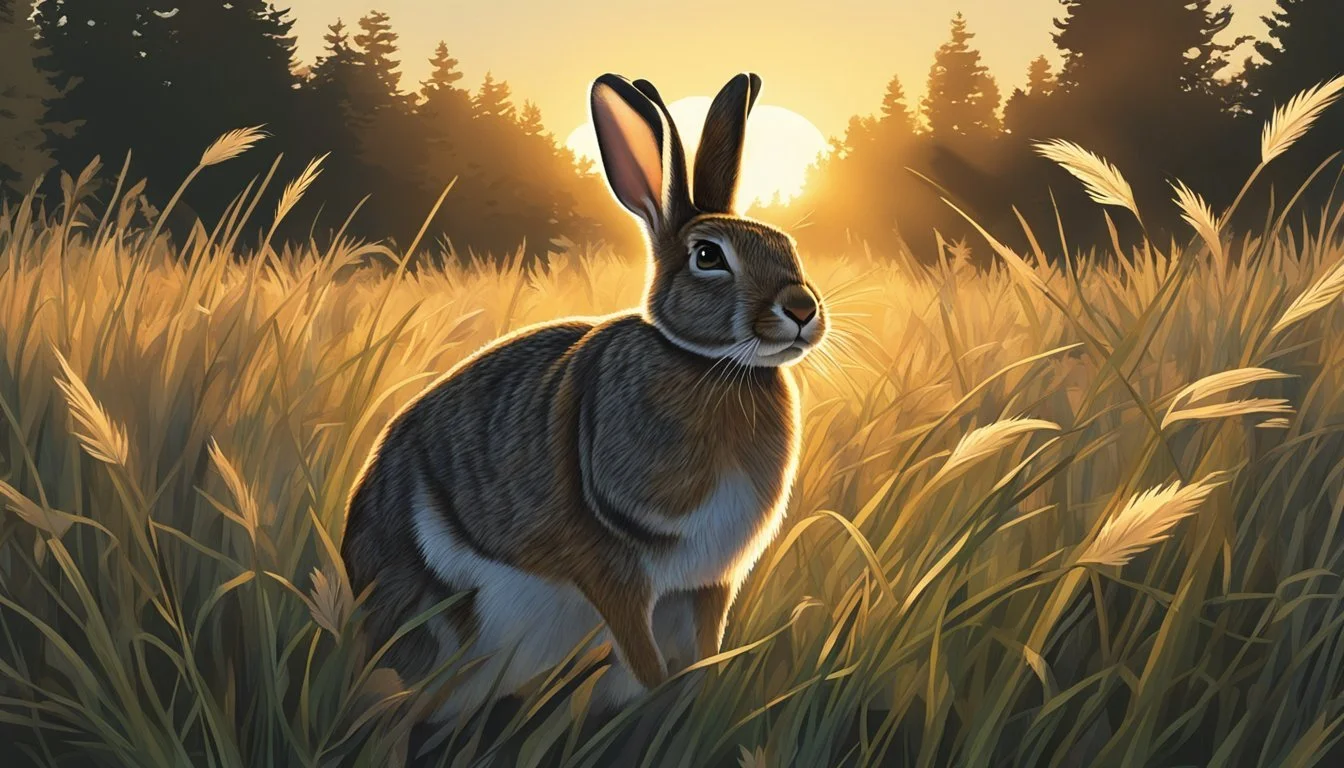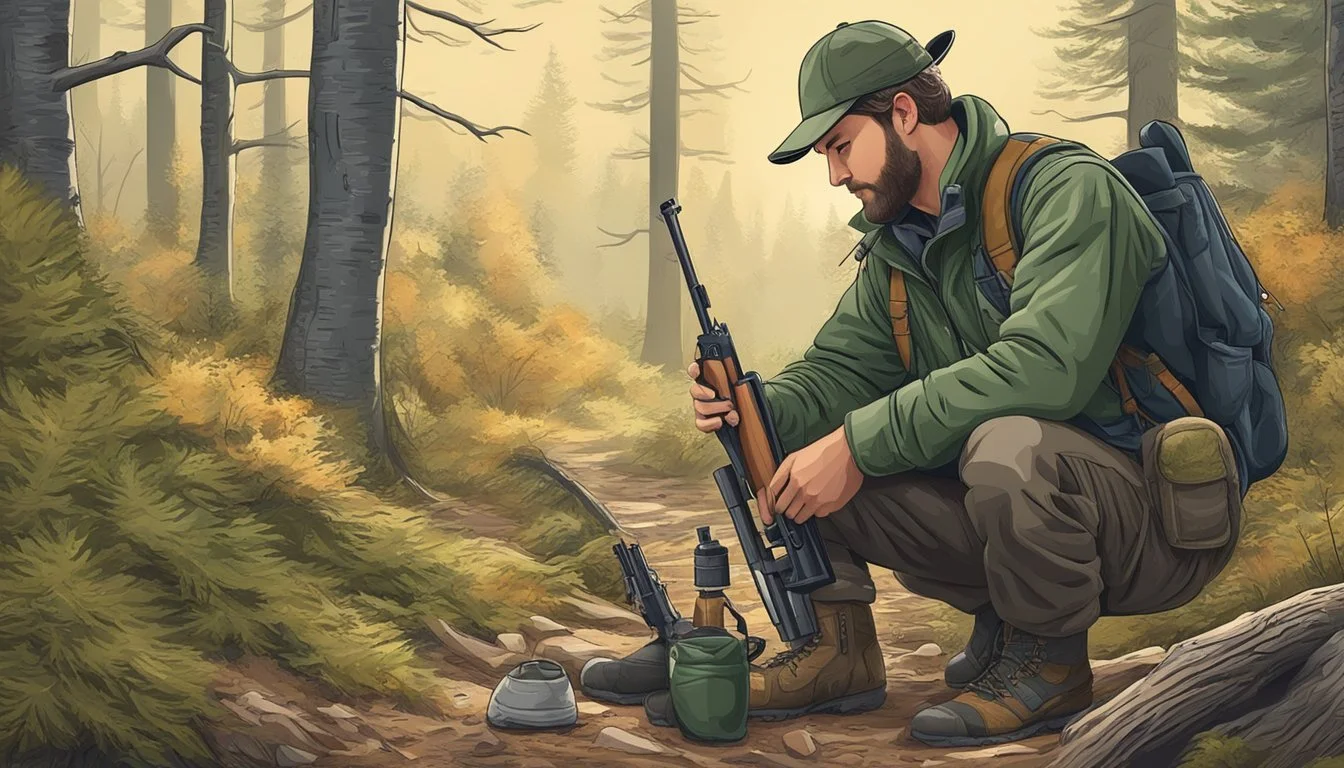Cottontail Rabbit Hunting Seasons
Regulations and Best Practices
This Article is Part of Our Guide on Hunting Seasons for Over 70 Common Game Species
Cottontail rabbit hunting is an accessible and engaging outdoor activity that appeals to numerous hunters across the United States. Characterized by its widespread availability, hunting these small game animals is a classic pursuit that allows hunters to sharpen their marksmanship and tracking skills. Cottontail rabbits thrive in a variety of habitats, making them a common target for hunters living in both rural and suburban areas.
The hunting seasons for cottontail rabbits vary by state, and regulations are often established to maintain healthy rabbit populations. During the designated seasons, hunters can apply different strategies and techniques to successfully harvest cottontails. Whether using shotguns or rifles, hunters must be adept at quick target acquisition due to the rabbit's agility and speed.
As an active form of hunting, pursuing cottontail rabbits can also serve as a social activity, where hunters can enjoy the camaraderie of working together with others or alongside trained hunting dogs. The culmination of a successful hunt is often rewarded with the opportunity to prepare and enjoy the game, as rabbit meat is renowned for its taste and culinary versatility.
Understanding Cottontail Rabbits
In order to effectively hunt cottontail rabbits, it is crucial to have a comprehensive understanding of their species, physical traits, habitats, and behavior. This knowledge is vital to identify the rabbits in the wild and predict their habits.
Species and Subspecies
Cottontail rabbits are a group that includes several species and subspecies, notable among them being the Eastern cottontail (Sylvilagus floridanus), Desert cottontail, and New England cottontail (Sylvilagus transitionalis). While the Eastern cottontail is widespread across America, the Desert cottontail is typically found in the arid regions of the Southwest, and the New England cottontail is more localized to areas in the Northeast.
Physical Characteristics and Identification
When identifying cottontail rabbits, look for the following distinct features:
Fur: Typically brown or gray with a rust-colored patch on the neck.
Ears: Long, with varying degrees of fur coverage.
Eyes: Characteristically large for their head size.
Tail: The tail is short, appearing as a small puff which is often light or white underneath, giving them their 'cottontail' name.
Physical traits can vary slightly between subspecies, but these are the general indicators.
Habitat and Range
Cottontail rabbits inhabit a wide range of areas across America. The Eastern cottontail prefers open landscapes with a mix of vegetation and woods, while Desert cottontails are suited to dryer, desert-like habitats. New England cottontails, on the other hand, often inhabit young forests and thickets. All subspecies will seek out environments that provide ample cover for nesting and protection from predators.
Behavior and Habits
Understanding the behavior and habits of cottontail rabbits can significantly increase hunting success. They are primarily crepuscular, being most active during dusk and dawn. Signs of their presence include distinct tracks, which feature four toes on both the front and back feet, and droppings, which are typically round, green when fresh, and found near feeding areas. They often warm themselves on south-facing slopes during winter and prefer to stay near dense thickets for safety.
Preparation for Hunting
Before venturing into the field, hunters need to ensure they have a clear understanding of the legal parameters for harvesting cottontails, possess the appropriate gear, and can identify signs of rabbit activity.
Legal Requirements and Bag Limits
States regulate rabbit hunting seasons and bag limits to ensure sustainable populations. Hunters must:
Obtain the necessary hunting licenses.
Adhere to species-specific bag limits which dictate the number of rabbits one may harvest per day.
Local regulations can vary, so it's imperative to check the local regulations for the specific area where hunting will occur.
Choosing the Right Gear
The right gear is crucial for a successful hunt. Hunters typically opt for:
A 20-gauge shotgun or a .22 caliber rifle for versatility and ease of use.
Camouflage clothing to blend into the environment.
Binoculars for spotting rabbits from a distance.
Depending on personal preference, some may choose a handgun for an added challenge.
Understanding Rabbit Sign
Recognizing signs of rabbit activity can greatly increase a hunter's success rate. Key indicators include:
Droppings: Rounded green pellets indicate recent activity.
Tracks: Distinctive patterns in the soil or snow.
Chewing and scratching on vegetation.
Identifying these signs helps hunters track rabbit movements and pinpoint hunting locations.
Hunting Strategies
Successful cottontail rabbit hunting requires a blend of knowledge, skill, and tactics. Hunters can utilize various strategies to increase their chances of a successful hunt, including spot and stalk techniques, still-hunting methods, engaging the acute senses of hunting dogs, and optimizing hunt times during dawn and dusk.
Spot and Stalk Technique
In the Spot and Stalk technique, hunters visually locate rabbits before making a careful approach. This method is particularly effective in open areas where visibility is high. The key is to spot the rabbit, typically resting or feeding, and then stalk to within shooting range. When walking, maintain silence and use natural cover for concealment.
Still-Hunting Method
Still-Hunting involves moving stealthily through rabbit habitat and pausing frequently to watch and listen. Hunters must be patient, as the goal is to catch the rabbit moving or to flush it from cover. It's a method that requires minimal equipment but a high level of alertness to spot the stationary target or to detect faint tracks and signs of activity.
Using Hunting Dogs
Introducing hunting dogs, such as beagles, into the hunt can significantly increase success rates. These dogs are trained to sniff out rabbits and flush them towards the hunter. The beagle is a preferred breed due to its size, endurance, and keen nose. Working with dogs means the hunter can focus on readying for the shot as the dog works the cover.
Best Times for Hunting
Rabbits are most active during dusk and dawn, making these times optimal for hunting. Hunters should capitalize on these periods when rabbits venture out for feeding. Cooler, overcast days can also extend rabbit activity beyond their usual dawn and dusk schedules, offering additional hunting opportunities.
By employing these strategies, hunters can make informed decisions and increase their likelihood of a successful cottontail rabbit hunt.
Shooting and Tracking
In cottontail rabbit hunting, success hinges on a hunter's choice of firearm and ammunition, their marksmanship and adherence to safety protocols, and their skill in tracking and spotting the elusive prey.
Effective Firearms and Ammunition
Choosing the right guns for cottontail rabbit hunting typically involves either a small-caliber rifle or a shotgun. A .22 caliber rifle is favored for its accuracy at a distance and the capacity for a clean head shot, which preserves the meat. For shotguns, a 20-gauge is often recommended due to its lighter weight and adequate power, which is less damaging to the meat compared to larger gauges.
Rifles: .22 caliber for precision
Shotguns: 20-gauge for less meat damage
When considering ammunition, one should opt for:
Rifle rounds: standard velocity .22 cartridges
Shotgun loads: smaller size shot such as #6 or #7.5
Marksmanship and Safety
Safety must always be a hunter's top priority. Hunters should be well-versed in firearm handling and safety rules. Good marksmanship is not only important for a successful hunt but also for ensuring ethical harvesting. Aiming for the head reduces suffering and spoiling of meat. Hunters should practice at the range to refine their shooting skills and ensure accuracy in the field. They should always have a clear line of sight to the target, and be mindful of what lies beyond it.
Preparation: Practice at the range
Goal: Clean, ethical head shots
Tracking and Spotting Techniques
Efficient tracking and spotting take advantage of understanding the rabbit's behavior and habitat. Cottontails rely on their sight and scent to evade predators. Hunters need to stay downwind to prevent their scent from alerting rabbits. They should move quietly and watch for signs of rabbit activity, such as fresh droppings or feeding signs. Using binoculars can enhance visibility and help spot rabbits before they detect human presence. Spotting cottontails often requires keen observation of subtle movement or irregular shapes within the environment.
Scent: Approach from downwind
Sight: Use binoculars for enhanced visibility
Observation: Look for signs of recent activity
After the Hunt
After a successful hunt, considerable attention must be paid to handling and processing the cottontail rabbit. This is crucial to ensure the quality of the meat and fur, and to honor the spirit of sustainable hunting practices.
Handling and Processing the Harvest
Proper handling begins immediately after the harvest. Hunters must field dress the rabbit, removing the innards to prevent the meat from spoiling. The fur is to be carefully skinned if it's intended for use. Each cottontail rabbit should be cooled down as soon as possible. When processing the meat, a hunter needs to:
Remove the head, feet, and pelt.
Separate the meat into sections: front legs, back legs, and backstraps.
Rinse the meat thoroughly under cold water.
Store the sections in a refrigerator or on ice if immediate cooking is not planned.
Cooking and Recipes
Rabbit meat is lean and high in protein, typically compared to chicken in taste. It's best cooked slowly to preserve moisture; methods like braising are excellent. One traditional recipe is rabbit stew, which often includes vegetables, stock, and herbs, slow-cooked until the meat is tender.
For a simple dish, a hunter might:
Braise the legs and backstraps with onions, garlic, and broth.
Incorporate herbs such as thyme and rosemary for enhanced flavor.
Serve the meat alongside root vegetables or over rice.
Conservation and Ethics
Conservation is essential in rabbit hunting. Hunters adhere to this by only taking what they can use and by following established seasons and limits to ensure populations remain stable. The ethics of hunting dictate that one should:
Respect the quarry: Only hunt when the rabbit population can sustain it.
Honor the meat: Use as much of the harvested animal as possible to avoid wastage.
Maintain the habitat: Advocate for and engage in conservation efforts to preserve the ecosystems where cottontail rabbits thrive.
Eating what is hunted reflects respect for the animal and contributes to the cycle of sustainable wildlife management.




